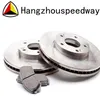When it comes to vehicle safety and performance, brake pad quality is paramount. Our brake pads are engineered to deliver exceptional stopping power, durability, and reliability under various driving conditions. Whether you drive a sedan, SUV, truck, or performance car, our products are designed to meet and exceed OEM standards, ensuring your peace of mind on the road.
Our brake pads are crafted with advanced materials and technology to provide superior performance. Below are the detailed specifications:
| Parameter | Value | Testing Standard |
|---|---|---|
| Friction Coefficient | 0.38 - 0.42 (mu) | SAE J661 |
| Operating Temperature Range | -40°F to 1,200°F (-40°C to 650°C) | ISO 26867 |
| Noise Level | < 70 dB at 30 mph | SAE J2521 |
| Dust Production | Low-dust formulation, < 0.5g per 1,000 miles | Internal testing |
| Service Life | Up to 60,000 miles under normal driving conditions | Real-world driving tests |
Our brake pads are available in multiple sizes to fit a wide range of vehicles. Check the compatibility chart below:
| Vehicle Type | Model Examples | Pad Dimensions (L x W x H in inches) |
|---|---|---|
| Sedans | Toyota Camry, Honda Accord | 5.2 x 2.5 x 0.6 |
| SUVs | Ford Explorer, Jeep Grand Cherokee | 6.0 x 3.0 x 0.7 |
| Trucks | Chevrolet Silverado, RAM 1500 | 6.5 x 3.5 x 0.8 |
| Performance Cars | BMW M3, Audi S4 | 5.8 x 2.8 x 0.65 |
Here are some frequently asked questions about brake pads to help you make an informed decision:
Squealing or grinding noises when braking, reduced braking performance, longer stopping distances, vibration in the brake pedal, or a dashboard warning light for brake wear are common indicators. Additionally, visual inspection showing less than 1/4 inch of pad material means replacement is due.
Typically, brake pads last between 30,000 to 70,000 miles depending on driving habits, vehicle type, and pad quality. Aggressive driving, frequent towing, or city driving with lots of stops can shorten lifespan. Regular inspections every 10,000 miles are recommended.
Ceramic brake pads, like ours, offer quiet operation, low dust, and consistent performance across temperatures. Semi-metallic pads provide excellent heat dissipation and are durable but may produce more noise and dust. Organic pads are softer, quieter, but wear faster and are less suitable for high-performance applications.
If you have mechanical experience and the right tools (jack, wrench set, C-clamp), DIY installation is possible. However, for safety and warranty purposes, we recommend professional installation to ensure proper bedding-in and avoid issues like uneven wear or brake fluid leaks.
Yes, our brake pads include a limited lifetime warranty against defects in materials and workmanship. This covers replacement if the pads fail under normal use, but does not cover wear from driving or improper installation. Always retain your purchase receipt for warranty claims.
Consider your driving style, vehicle type, and performance needs. For daily commuting, ceramic pads are ideal for comfort and low maintenance. For heavy-duty use like towing or racing, semi-metallic might be better. Always check compatibility with your vehicle's make, model, and year using our online fit guide.
Bedding-in involves gradually heating the pads to transfer a layer of material onto the rotor for optimal performance. After installation, drive at moderate speed and apply brakes firmly from 35 mph to 10 mph several times, allowing cool-down periods. Avoid hard braking for the first 200 miles to prevent glazing.
Yes, ceramic brake pads are more environmentally friendly as they produce less dust, which reduces airborne pollutants and keeps wheels cleaner. They also often contain fewer heavy metals compared to semi-metallic options, making them a greener choice.


